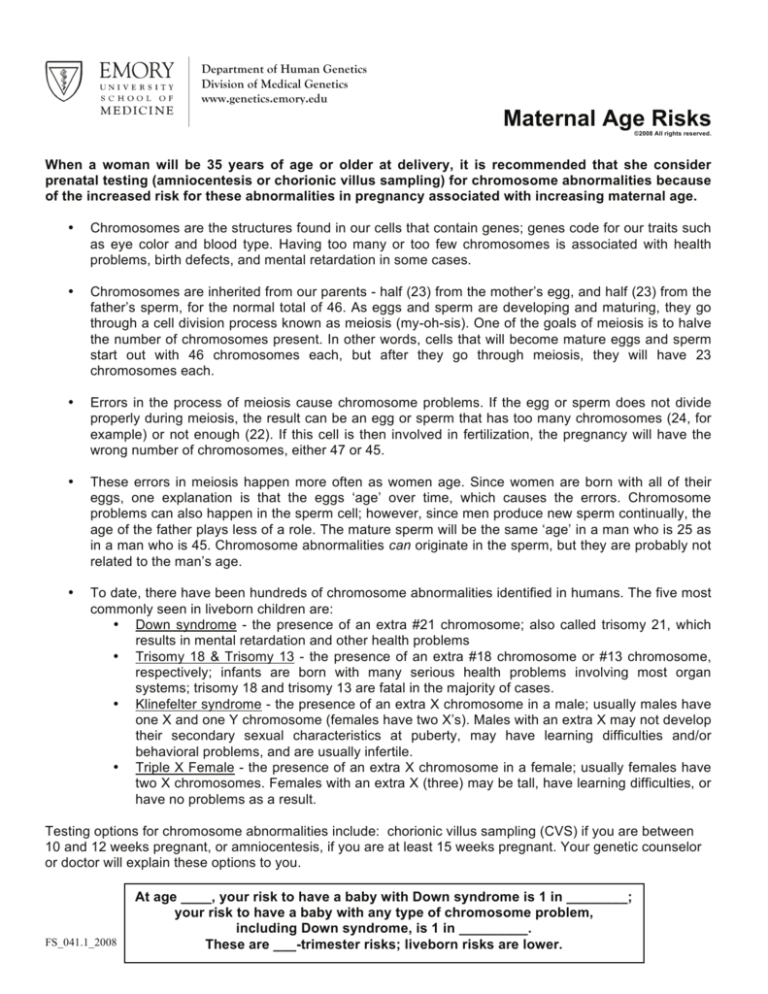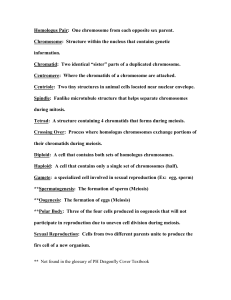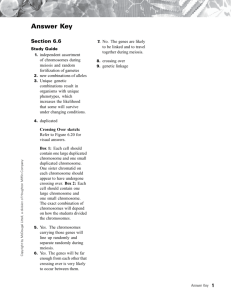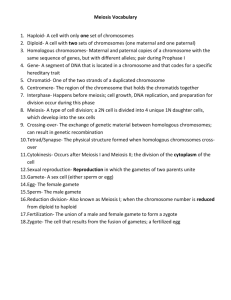
Department of Human Genetics
Division of Medical Genetics
www.genetics.emory.edu
Maternal Age Risks
©2008 All rights reserved.
When a woman will be 35 years of age or older at delivery, it is recommended that she consider
prenatal testing (amniocentesis or chorionic villus sampling) for chromosome abnormalities because
of the increased risk for these abnormalities in pregnancy associated with increasing maternal age.
•
Chromosomes are the structures found in our cells that contain genes; genes code for our traits such
as eye color and blood type. Having too many or too few chromosomes is associated with health
problems, birth defects, and mental retardation in some cases.
•
Chromosomes are inherited from our parents - half (23) from the mother’s egg, and half (23) from the
father’s sperm, for the normal total of 46. As eggs and sperm are developing and maturing, they go
through a cell division process known as meiosis (my-oh-sis). One of the goals of meiosis is to halve
the number of chromosomes present. In other words, cells that will become mature eggs and sperm
start out with 46 chromosomes each, but after they go through meiosis, they will have 23
chromosomes each.
•
Errors in the process of meiosis cause chromosome problems. If the egg or sperm does not divide
properly during meiosis, the result can be an egg or sperm that has too many chromosomes (24, for
example) or not enough (22). If this cell is then involved in fertilization, the pregnancy will have the
wrong number of chromosomes, either 47 or 45.
•
These errors in meiosis happen more often as women age. Since women are born with all of their
eggs, one explanation is that the eggs ‘age’ over time, which causes the errors. Chromosome
problems can also happen in the sperm cell; however, since men produce new sperm continually, the
age of the father plays less of a role. The mature sperm will be the same ‘age’ in a man who is 25 as
in a man who is 45. Chromosome abnormalities can originate in the sperm, but they are probably not
related to the man’s age.
•
To date, there have been hundreds of chromosome abnormalities identified in humans. The five most
commonly seen in liveborn children are:
• Down syndrome - the presence of an extra #21 chromosome; also called trisomy 21, which
results in mental retardation and other health problems
• Trisomy 18 & Trisomy 13 - the presence of an extra #18 chromosome or #13 chromosome,
respectively; infants are born with many serious health problems involving most organ
systems; trisomy 18 and trisomy 13 are fatal in the majority of cases.
• Klinefelter syndrome - the presence of an extra X chromosome in a male; usually males have
one X and one Y chromosome (females have two X’s). Males with an extra X may not develop
their secondary sexual characteristics at puberty, may have learning difficulties and/or
behavioral problems, and are usually infertile.
• Triple X Female - the presence of an extra X chromosome in a female; usually females have
two X chromosomes. Females with an extra X (three) may be tall, have learning difficulties, or
have no problems as a result.
Testing options for chromosome abnormalities include: chorionic villus sampling (CVS) if you are between
10 and 12 weeks pregnant, or amniocentesis, if you are at least 15 weeks pregnant. Your genetic counselor
or doctor will explain these options to you.
FS_041.1_2008
At age ____, your risk to have a baby with Down syndrome is 1 in ________;
your risk to have a baby with any type of chromosome problem,
including Down syndrome, is 1 in _________.
These are ___-trimester risks; liveborn risks are lower.










